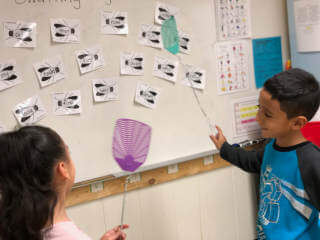It's by no accident that the first two SIOP* features have to do with writing clear objectives. The fact that writing language objectives is addressed apart from writing content objectives hints at its importance.
Considering the language objective(s) that accompanies each content objective demonstrates how important conscious attention to language development is in the SIOP framework.

In addition to determining the content objective, SIOP asks us to turn our attention to the language that is connected to the class content. Writing a language objective serves two purposes. First, it makes the teacher (and students) more conscious of the exact language the students will own in addition to the lesson's content. Rather than just 'winging it' and supposing that students will learn some language, SIOP has teachers decide exactly what that language is. Secondly, beginning the entire process with clear content & language objectives anchor their importance in planning and teaching. Indeed, language & content objectives are explicitly mentioned in 5 of the 8 components of SIOP and implicitly mentioned in the rest.
What's the difference between a content objective and a language objective?
Content Objective: Create and label correctly a bar graph that represents data from the class survey.
Language Objective: Explain to a partner what the bar graph shows using the phrases correlation, sample, bias, probability, outlier.
Notice the difference between the two:
The first one, the content objective, deals with content only (create and label a graph) where as the language objective explains how the students will interact with that content (by using specific language to describe the graph to a peer).

The language objective has two distinct parts.
Considering what specific language task students will do and what specific language they will use to do it can profoundly impact learning in the classroom.
The key word is specific. English learners can't leave anything to chance. Their needs are too great. We teachers should do the same.
Having the content and language objectives help both the teacher and student get off on the right foot. Since both of these objectives begin with the students in mind (SWBAT or Students Will Be Able To), it makes sense that teachers consider what their students will need in order to attain the objectives that they laid out.
The beauty of the language objective is it encourages teachers to consciously consider specific language outcomes for the students.
Writing effective objectives is challenging. Ask any teacher. S/he'll tell you about the struggles in satisfying the requirement. If you ask an administrator, s/he'll say something similar.
TESOL Trainers can help your faculty write effective objectives that meet the needs of every student. Contact TESOL Trainers to learn about K-12 staff development opportunities for SIOP, TESOL strategies, and more. John Kongsvik and his team of trainers will design the perfect training program for your teaching staff.
Our teacher training workshops can help educators see how online synchronous platforms like Zoom and Google Meet can engage their students. We provide teachers with tips on how to use tools like Pear Deck, Nearpod, Jamboard, Kami and a lot more to make learning more meaningful and more engaging.
TESOL Trainers trains teachers on how to use Google Classroom in synchronous and asynchronous ways that support all students, regardless of their backgrounds. Our ideas are practical, novel, and inspiring. Teachers leave our PD with confidence and competence!
Click the button below to claim your free ebook and join our mailing list.